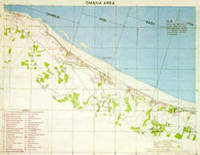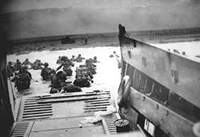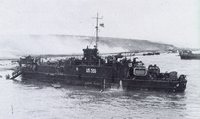
|
 1st Infantry Division
1st Infantry Division
" Big red one
" |  29th Infantry Division
29th Infantry Division
" Blue and
gray " | The
stretch of coast coded Omaha is a sandy beach located between Vierville sur Mer
to the west and Colleville sur Mer to the east. This 6 km-long beach is flanked
on each extremities by cliffs up to 60 meters high and plunging directly into
the sea. The beach itself is dominated by a 40 meters high, steep-sloped grassy
ridge.
| Bracketed between
high cliffs, the beach only has five draws of varying suitability. 5 kilometers
to the west is the Pointe du Hoc, a 30 meters-high rocky cliff. The
352.ID and 716.ID are in charge of the defense of this coastal sector. The main
line of resistance is made of a serie of WNs bordering the beach and interdicting
the access to the draws; no concrete work has been built inland. Backing the beach
defenders are several artillery battalions of the 352.ID in position a few miles
behind, between La Cambe and Formigny, and equiped with twenty-four 105mm and
150mm howitzers that are able to fire on all of the 6 kilometers of coast.
The passive defence is made of several antitank
ditches and walls along the beach and numerous beach obstacles: stakes, tetrahedrons,
"C" elements and Begian Gates.
|

Omaha Beach Sector |
|
The Objectives :
The goal of the landings in this sector is to establish a beachhead between Port en Bessin and
the Vire river and then push south towards Caumont and Saint-Lô alongside
the Second British Army. Once the beaches have been cleared, the troops will head
inland and reach a line going from Isigny to Tour en Bessin and link up with the
Rangers at the Pointe du Hoc to the west and the british 47th Royal Marine Commando
at Port en Bessin to the east.
The
invasion :
The bad weather,
the strong tide currents and low visibility will completely disorganize the landing
schedules of the first waves assault companies. |
|
The preliminary bombardement
by the Air Force miss the WNs due to zero visibility, the bombers dropping their
loads too far inland. Those are intact defenses that the eight companies of the
first wave will face.
The
tanks scheduled to support the first assault troops are also missing. The DDs
of the 741st Tank Battalion launched off shore nearly all sank due to the strong
sea, only two tanks out of 29 of B and C Companies will hit the beach. At
0630 hrs the first LCAs and LCVPs are approaching the beach and the german open
fire furiously, all hell breaking loose the moment the ramps are being lowered.
The GIs find a completely flat beach with no cover and raked by german machineguns,
AT guns and mortars. On top of that, most of the landing crafts have drifted to
the east because of the strong tide currents and men are not landing on their
assigned sector and find themselves intermingled with other squads and companies. |
 Elements of the 1/16 Inf Rgt
Elements of the 1/16 Inf Rgt
( Robert F. Sargent - USASC
) |
|
Company A/116 loses almost all it's officers in the first 15 minutes, the
men being pinned down at water's edge, or hiding behind the beach obstacles and
refusing to advance, paralysed with fear. Except for a few sectors, it's the same
situation all over the beach: men pinned down behind the shingle, behind destroyed
vehicles, beach obstacles or lying down at water's edge and advancing only with
the rising tide. |
|
The second wave of reinforcements
begin to land at 0700 hrs and meet the same fate and men and materiel losses are
mounting by the minute.
Nonetheless,
begining around 0800, some officers start to organize small groups of men and
lead them to assault the first strong points. Despite high casualties, equipment
losses and disorganisation, a large portion of the assault troops did not remain
pinned down, encouraged and inspired by a handfull of valorous officers and non-comissioned
officers who take their lead. These early penetration were to influence the rest
of the day's action on Omaha Beach.
The most important condition to improve
the situation on the beach was to push the vehicles inland. This was made possible
after the destroyers and the 18th Infantry Regiment had reduced the german resistance
at the E-1 draw. |
 LCI 553 land troop on Fox Green
LCI 553 land troop on Fox Green
( USA Signal Corps ) |
| By early
afternoon, vehicles were able to advance through the Ruquet valley. For the other
draws, the efforts to open them to traffic only succeeded late in the afternoon.
The
End of the Day :
The assault
on Omaha had succeeded but had been much more harder than what was envisioned.
Generally speaking, clearing and organizing the beach had just begun by nightfall.
The penetrations made in the morning by relatively small groups lacked the power
to thrust deep inland and a fierce german resistance had confined the advance
to a narrow beachhead no larger than one and a half mile in the Colleville area.
Behind the US lines, german pockets still refused to cease fighting.
Needless
to say, none of the D-Day objectives assigned to the 1st Infantry Division had
been reached, neither the penetration towards route 13 nor the junction with the
british at Port en bessin or the Rangers at the Pointe du Hoc.
As
the end of the day a first assesment can be made: it was close call and a disaster
had been narrowly avoided. Only 100 tons of materiel had be landed out of the
2,400 planned but more than that, the human losses have been staggering, on the
34,000 men landed, the americans had lost around 4,720 killed, wounded or missing
on the beach which would be forever known as 'Bloody Omaha'. |
|




